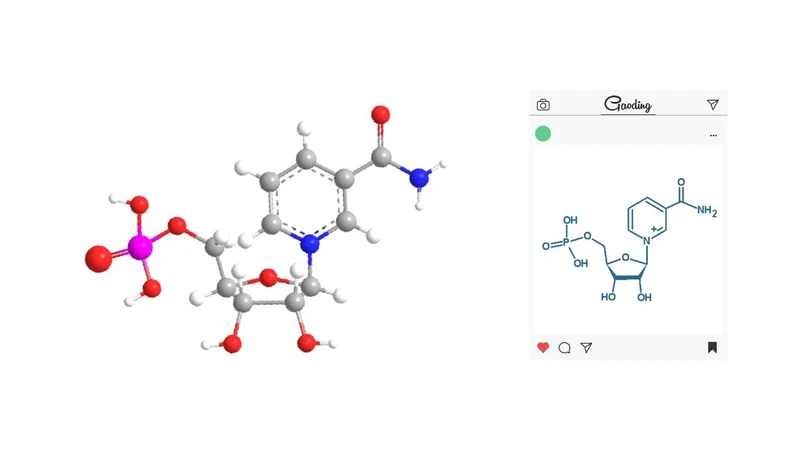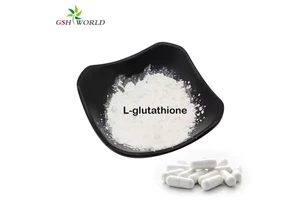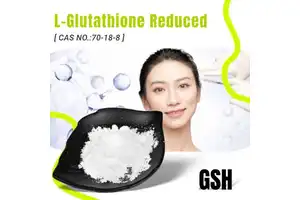Glutathione common whitening ingredients detailed
What is glutathione?
Alias: reduced glutathione; 5-L-glutathione; L-reduced glutathione
Molecular formula: C10H17N3O6S
Molecular weight: 307.3
CAS number 70-18-8
Chemical structure formula:

Physical and chemical properties
Glutathione is a white crystalline powder, its melting point is 182~195℃ can dissolve in water, insoluble in alcohol, ether and acetone.
Safety management situation
The State Food and Drug Administration issued the "Catalogue of used Cosmetic Raw Materials (2015 edition)" to include glutathione
Glutathione is widely found in animals, plants and microorganisms. It is one of the most important non-protein euclidyl compounds in living organisms, including reduced glutathione (GSH) and oxidized glutathione (GSSG). Glutathione is abundant in living organisms and its main function is glutathione.
2 GSH molecules are dehydrogenated and condensed by disulfide bonds to form oxidized glutathione (GSSG), also known as glutathione disulfide. Glutathione is formed by glutamic acid, GSH is formed by glutamic acid and cysteine through peptide bonds. There is a special Y-peptide bond in the molecule, that is, a peptide bond condensed by y-COOH of glutamic acid and A-NH of cysteine, which is different from the common peptide bond in protein molecules.
Y-glutamyl and mercapto-SH on the cysteine side chain group in the structure of glutathione are the structural basis of many important physiological functions of glutathione:
① Glutathione is involved in cellular REDOX reactions, is a coenzyme of some enzymes, and has an activation effect on some basic enzymes:
② The thiol group on the structure of glutathione is thiol-containing enzyme and protein-based stability, and is an antioxidant to protect enzymes and other protein-based;
③ Participate in transmembrane amino acid transport through intracellular metabolic cycles (such as glutamyl cycle and tricarboxylic acid cycle);
④ Glutathione plays an important role in the detoxification of foreign bodies and the removal of hydroxyl peroxide and free radicals;
⑤ Glutathione can bind free radicals and peroxides in metabolism, prevent lipid peroxidation of mitochondria, and protect cells against oxidative damage caused by reactive oxygen species and derivatives formed under normal and ultraviolet irradiation.
Clinically, glutathione is widely used to treat liver diseases, tumors, oxygen-toxic aging and endocrine diseases:
In the food manufacturing industry, glutathione is a bioactive additive and antioxidant, known as longevity factor and anti-aging factor.
Skin whitening mechanism of glutathione
Glutathione is a compound that is ubiquitous in our bodies. Its main physiological functions in the body include scavenging free radicals, anti-oxidation, anti-aging, and it is also related to skin whitening.
We review in vitro and in vivo studies of melanin production, showing that it is involved in an important part of the melanin pathway and regulates skin pigmentation.
Glutathione's mechanism of action includes:
- ① The activity of tyrosinase is directly inhibited by binding to the cupr-containing active site of the enzyme;
- ② Regulating the transition mechanism from eumelanin to phaeomelanin production;
- ③ Scavenging free radicals and peroxides that contribute to tyrosinase activation and melanin formation;
- ④ Regulate the decolorization ability of melanocyte toxic agents (benzoquinone, o-quinone, etc.). These mechanisms of action are supported by various experimental data, which lays a foundation for the study of glutathione in the treatment of pigmented diseases.
During melanin synthesis, GSH is critical for the formation of phaeomelanin, as it mediates the mechanism of conversion from eumelanin to phaeomelanin production.
Glutathione or cysteine binds to dobacone in a non-enzymatic reaction that rapidly produces Glutathionyldopas or Cysteinyldopas, glutathione binds to dobacone in the presence of glutathione S-transferase.
The melanin synthesis route changes from eumelanin direction to phaeomelanin direction, promoting the amount of phaeomelanin synthesis, and phaeomelanin appears yellow and red, and finally whitening the skin.
The skin-whitening effect of glutathione is also attributed to its antioxidant activity.
Glutathione has the ability to clear ROS produced by epidermal cells after UV irradiation, thereby preventing ROS-induced melanin production.
Other whitening agents with antioxidant activity and inhibition of melanin production, including L-ascorbic acid and its derivatives, also follow this mechanism.
The use of glutathione in cosmetics
GSSG is not easily decomposed in aqueous solution and is suitable for use in liquid form, and also has a good skin whitening effect.
Fumiko Watanabe et al. investigated the skin whitening effect of GSSG in a 10-week randomized, double-blind clinical trial in which 30 female subjects (30 to 50 years old) were administered 2% GSSG on one side of the face and placebo on the other side twice a day. Changes in cuticle moisture content, smoothness, wrinkle formation, and skin elasticity.
The results showed that the skin melanin index in the GSSG group was significantly lower than that in the placebo group.
In the second half of the study, the water content of the stratum corneum at the site treated with GSSG was significantly increased, and wrinkles and skin smoothness were significantly improved.
Next: Glutathione tablets









